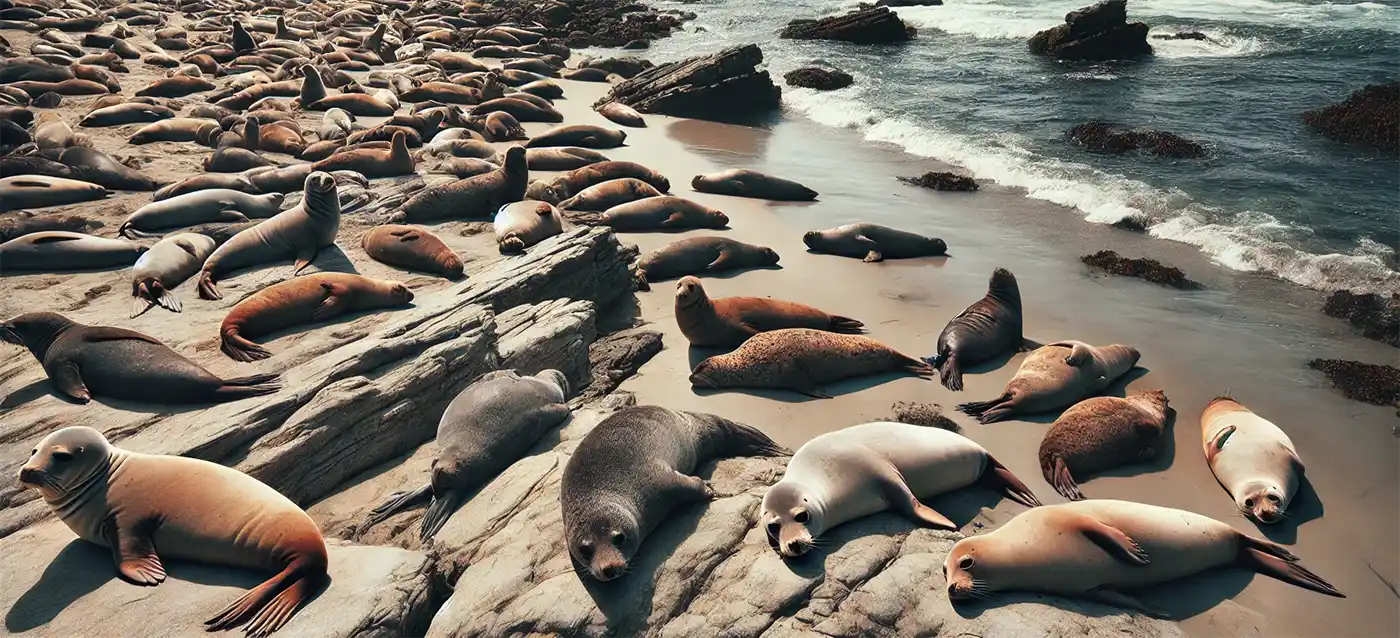Honoring the Ocean’s Most Adorable Acrobats!
Every year on March 22nd, animal lovers, conservationists, and marine enthusiasts around the world celebrate International Day of the Seal! This special day is dedicated to raising awareness about the importance of seals in marine ecosystems, the challenges they face, and the efforts to protect these flippered wonders. Whether they’re basking in the sun, performing gravity-defying leaps, or just being effortlessly cute, seals deserve a day of appreciation—and maybe a fishy snack or two.
Meet the Seals – The Charismatic Marine Mammals
Seals belong to the pinniped family, which means “fin-footed.” They are close relatives of sea lions and walruses, but unlike their louder, more extroverted cousins, seals are the introverts of the pinniped world—preferring to keep things quiet while they glide through the ocean like underwater torpedoes.
There are over 30 species of seals, ranging from the massive elephant seal, which can weigh over 8,000 pounds, to the dainty Baikal seal, the world’s only freshwater seal. These marine mammals inhabit coastlines and icy waters around the globe, from the sunny beaches of California to the frigid landscapes of Antarctica.
Seals are highly adaptable creatures, capable of thriving in both extreme cold and temperate coastal environments. Some species, like the Weddell seal, can survive in sub-zero Antarctic conditions, while others, like the Harbor seal, prefer milder coastal regions. Despite their sometimes sluggish appearance on land, seals are incredibly agile swimmers, using their powerful back flippers to propel themselves effortlessly through the water.
Socially, seals vary by species. Some, like gray seals, gather in large colonies for breeding, while others, such as leopard seals, are more solitary and prefer the open ocean. Regardless of their social tendencies, all seals rely on blubber for insulation, allowing them to withstand frigid waters and maintain body heat.
Why Are Seals Important?
Aside from being effortlessly charming, seals play a vital role in marine ecosystems. Here’s why they matter:
- Top-Tier Ocean Predators – Seals help maintain balance in the food chain by keeping fish and squid populations in check.
- Dinner for Bigger Predators – While they may be predators themselves, seals are also on the menu for sharks and orcas, ensuring a balanced marine environment.
- Ocean Health Indicators – The health of seal populations reflects the overall state of the oceans. If seals are struggling, chances are, something is wrong in the ecosystem.

Seals vs. Sea Lions – Know the Difference!
Not all flippered mammals are created equal! Here’s how to tell seals apart from their sea lion cousins:
| Feature |
Seals 🦭 |
Sea Lions 🦁 |
| Ears |
No visible ear flaps |
Cute little ear flaps |
| Mobility |
Awkward belly wiggle on land |
Walks with front flippers like a pro |
| Noisiness |
Quiet and reserved |
Loud, barking socialites |
| Swimming Style |
Swims with back flippers |
Uses front flippers like underwater wings |
Threats to Seals – Why They Need Our Help
Despite their adaptability, seals face serious threats due to human activity. Some of the biggest challenges include:
- Climate Change – Melting ice threatens seals in the Arctic and Antarctic, making it harder for them to rest and give birth.
- Pollution – Plastic waste, oil spills, and toxins are poisoning their waters and food sources.
- Overfishing – Depleting fish populations means seals have to work harder for their meals—imagine having to swim miles just to find dinner!
- Hunting & Bycatch – Seals are still hunted in certain regions, and many become accidental victims of fishing nets.
How to Celebrate International Day of the Seal
International Day of the Seal is a perfect time to show appreciation for these amazing marine mammals and take action to help protect them. Whether you’re near the coast or inland, there are plenty of ways to get involved and make a difference.
- Adopt a Seal! – Many marine organizations offer symbolic seal adoptions to support conservation efforts. No, you can’t keep one in your bathtub.
- Reduce Plastic Waste – Cut back on single-use plastics and participate in beach cleanups to keep seal habitats clean.
- Visit a Marine Sanctuary – Learn more about these amazing creatures at an accredited aquarium or marine reserve.
- Share the Love – Post a fun fact, picture, or seal pun on social media. After all, seals deserve a little extra flipper-clapping recognition!
Fun Seal Facts – Because They’re Awesome
Seals are not only adorable, but they are also full of surprises. These fascinating creatures have some incredible adaptations and quirky behaviors that make them even more lovable. Here are some fun facts to impress your fellow marine enthusiasts:
- Seals can sleep underwater – They can hold their breath for up to two hours and take power naps while floating!
- Harp seal pups look like fluffy clouds – Their white fur camouflages them on ice, but also makes them heartbreakingly adorable.
- Elephant seals are the deep-diving champions – They can reach depths of 5,000 feet and hold their breath for nearly two hours.
- Seals are super swimmers – Some species can reach speeds of 25 mph in the water—basically, the Michael Phelps of the ocean.
- They have built-in sunglasses – Seals’ eyes are adapted to see in both bright sunlight and murky depths.
International Day of the Seal is not just about appreciating how cute they are (though let’s be honest, they are ridiculously cute)—it’s about recognizing their role in marine ecosystems and the urgent need to protect them. So, whether you’re watching seal videos, donating to conservation programs, or simply telling a friend about these fascinating flippered friends, every effort helps make the world a safer place for seals.
Let’s give a big round of applause—or should we say flipper claps—for the seals of the world!
Please Share our Content
















 "Sláinte!" is a traditional Irish expression used as a toast, equivalent to "Cheers!" in English.
"Sláinte!" is a traditional Irish expression used as a toast, equivalent to "Cheers!" in English.